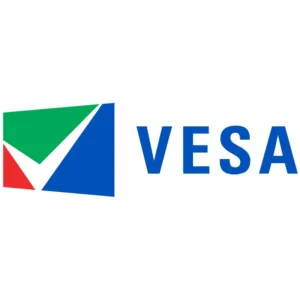The Video Electronics Standards Association (VESA®) today announced it has published the Embedded DisplayPort (eDP) standard version 1.4b. This new release takes the original eDP 1.4 standard to production-ready status, incorporating a number of key protocol refinements and clarifications resulting from VESA member companies’ product development efforts.
These enhancements to the eDP standard were specified to further optimize interoperability and time to market for developers of integrated displays and personal electronic devices, enabling improved flexibility of system implementation, reduced device complexity and lower bill of materials (BOM) costs.
Since the original publication of the eDP 1.4 standard more than two years ago, the PC and tablet industry has worked together within VESA to refine the specification as eDP 1.4-enabled components and products have been developed. As with eDP 1.4a, published in early 2015, the eDP 1.4b standard incorporates features of the VESA DisplayPort (DP) Standard v1.3 (December 2014). The GPUs and CPUs that support DisplayPort 1.3 can also drive the eDP 1.4 interface.
“From the onset, the development of eDP 1.4 has been all about power optimization,” stated Craig Wiley, senior director of marketing at Parade Technologies and editor of the DisplayPort 1.4 Standard. “Prior to eDP 1.4, eDP provided the highest performance and most optimized hardware interconnect, but not the lowest-power display interface for a given display resolution. As the largest supplier of eDP-enabled Sink devices, Parade is routinely pushed by chip set, panel, and platform OEMs to reduce device power, which has the benefit of reducing system form factors and extending battery life. eDP 1.4 puts eDP on parity with any other embedded interface regarding power consumption. Even with its added complexity, eDP is now more attractive even to the smallest devices because of its advantages. Along with our OEM partners, Parade believes that the eDP 1.4b release now represents the final eDP 1.4 implementation, and is now introducing Tcon products based on this standard.”
According to Bill Lempesis, executive director at VESA, “Since its introduction in 2008, eDP has become a central system element within the mobile computing market space. The standard has continued to retain its lead in display performance, supporting embedded panels with resolutions as high as 8K. We look forward to seeing systems incorporating the finalized standard come to fruition next year, broadening the number of consumers receiving clear, crisp visual information delivered by eDP 1.4 on their laptops, tablets, all-in-one PCs and possibly even smart phones.”
Like the previous eDP 1.4a standard, eDP 1.4b specifies four high-speed HBR3 lanes between the graphics adapter and display, with each lane operating at an 8.1 Gbps link rate. The lanes can be divided up between two or four independent panel segments, or used all together for a total theoretical payload bandwidth of 25.92 Gbps. One update to the original eDP 1.4 standard, which lowers system BOM cost, is an addition made to the Selective Update protocol for Panel Self Refresh. When sending the sub-frame video block for the partial update region, the Selective Update command from the video source now includes the Y-axis coordinate (line number) of where the region begins, instead of just the X-axis coordinate. Because this requires less precision in the asynchronous time base of the sink device, there is no need to include a discrete quartz crystal or crystal oscillator, as required by the original eDP 1.4 standard.
Another update to the standard is reduced granularity of the X- and Y-axis of the selective update region. Lowering the granularity can reduce the complexity of the display’s remote frame buffer implementation, thereby simplifying internal video compression implementation without diminishing the advantages of eDP 1.4.
Refinements were also made to the Selective Update protocol, as well as to the Multi-SST Operation (MSO) feature and the use of Display Stream Compression (DSC), Advanced Link Power Management (ALPM), and the auxiliary channel-based frame synchronization. Some of these refinements were made to simplify system design while others were made to further clarify implementation. Other parts of the standard were also updated to improve clarity and reduce ambiguity, minimizing the hurdles to launching the eDP 1.4 ecosystem.
While eDP 1.4b represents the latest VESA Embedded DisplayPort standard, systems in production today are using displays built to eDP 1.3 and earlier. By mid-2016, systems will begin to incorporate eDP 1.4b, and the final standard should continue to increase in adoption and be used in production for several years. In the meantime, VESA members will begin discussing plans for eDP 1.5, which will take advantage of new features that will be introduced in the future release of DisplayPort 1.4. The eDP 1.4b standard is available to VESA members. More information is available at www.vesa.org.

